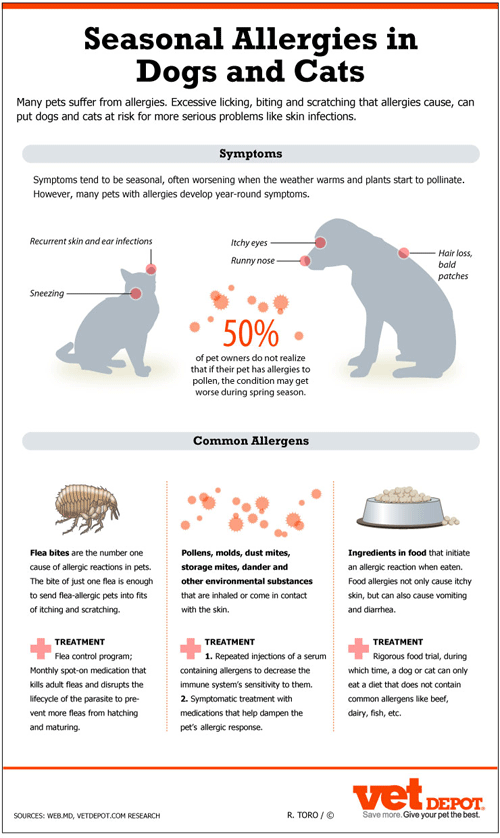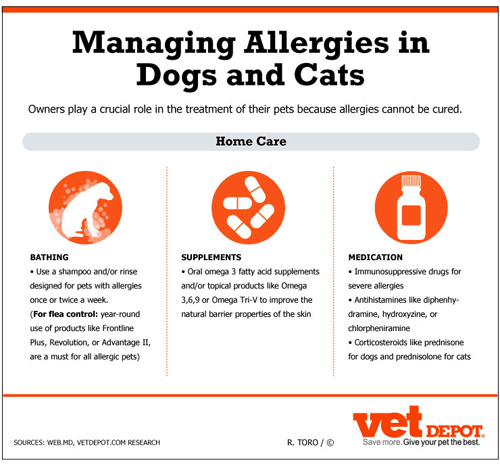Many pets suffer from allergies that seem to worsen with the seasons. The excessive licking, biting, and scratching that allergies cause are more than just an annoyance. The damage that results puts dogs and cats at risk for even more serious problems like skin infections and hot spots.
"Because allergic symptoms are essentially the same no matter what the underlying cause, it can be difficult to determine what is triggering a dog or cat’s response."
What Is An Allergy?
An allergy can be defined as “an abnormal reaction of the body's immune system to substances that often do not incite a similar reaction in other individuals.”1 In other words, the body mounts a particular type of immune attack against a trigger (e.g., pollen) that is actually harmless to the individual. Unfortunately, the effects of allergic reactions are far from harmless.

The Effects of Seasonal Allergies
Most people with seasonal allergies suffer from itchy eyes, sneezing, and a stuffy/runny nose. Dogs and cats are different. The number one symptom associated with allergies in pets is itchy skin. Sometimes the itching is limited to certain parts of the body (e.g., the face or feet). In more severe cases, almost no patch of skin is unaffected. Dogs and cats may scratch and chew at themselves to the point where they develop raw oozing sores. Other common symptoms include:
- Recurrent skin and ear infections
- Hair loss
- Scratching or shaking the ears
These symptoms tend to be seasonal at first, often worsening when the weather warms and plants start to pollinate and then improving in the fall/winter. With time however, many pets with allergies develop year round symptoms.
What Could My Pet Be Allergic To?
Common allergens fall into three categories:
- Flea bites – the number one cause of allergic reactions in pets. Do not discount the possibility of a flea allergy if you can’t find fleas on your dog or cat. The bite of just one flea is enough to send flea-allergic pets into fits of itching and scratching. The obsessive self-grooming that itchy dogs and cats perform also removes most of the evidence that fleas are present.
- Pollens, molds, dust mites, storage mites, dander, and other environmental substances that are inhaled or come in contact with the skin. The underlying genetic tendency toward this type of allergy is called atopy.
- Ingredients in food that initiate an allergic reaction when eaten. Food allergies cause itchy skin, but gastrointestinal signs like vomiting and diarrhea may also be present. Allergies associated with food are generally not seasonal unless a pet’s diet is changed.
Because allergic symptoms are essentially the same no matter what the underlying cause, it can be difficult to determine what is triggering a dog or cat’s response.

Veterinary Care for Allergies in Pets
Veterinarians will often tentatively diagnose allergies based on a pet’s clinical signs, a physical exam, and a few simple tests to rule out other common skin diseases, but figuring out exactly what a dog is allergic to can require time and patience.
Implementing an impeccable flea control program is a good place to start. Every itchy dog and cat should receive an effective, monthly spot-on medication like Frontline Plus, K9 Advantix II, or Revolution that kills adult fleas and disrupts the lifecycle of the parasite to prevent more fleas from hatching and maturing. Many of these products have the added benefit of also treating other common causes of itching in dogs and cats, such as certain types of mange.
Pets that are allergic to pollen, mold, dander, etc. can undergo intradermal skin testing or a blood test to determine what their triggers are. If they are allergic to something that can be removed from the environment, that should be the focus of treatment, otherwise owners have two options:
- Hyposensitization therapy involving repeated injections of a serum containing a pet’s allergens to decrease his immune system’s sensitivity to them.
- Symptomatic treatment with medications and other therapies that help dampen the pet’s allergic response and reduce itching (see below).
Food allergies are diagnosed through a rigorous food trial that last from two to three months, during which time, a dog or cat can only eat a diet that does not contain common allergens like beef, dairy, fish (especially cats), wheat, chicken, lamb, and soy.3 If the pet’s symptoms at least partially resolve during this time, a diagnosis of a food allergy is made.
Treating Your Pet's Allergies at Home

Because allergies cannot be cured, only managed, owners play a crucial role in the treatment of their pets. Keep in mind that many dogs and cats are allergic to more than one thing. For example, a dog might be allergic to beef in his food, mold spores, and flea bites. Multiple forms of therapy may be necessary.
Food allergic dogs and cats must avoid eating the offending ingredients if they are to remain symptom-free. Owners may choose to continue feeding the diet that that was used during the food trial or to slowly start reintroducing ingredients to determine exactly what their pet’s triggers are. These allergens cannot be included in any future diets. Special hypoallergenic diets like Purina HA Hypoallergenic Formula Dog Food are available.
Dogs and cats with environment allergies who aren’t candidates for hyposensitization therapy can usually be successfully managed with some combination of the following:
- Bathing once or twice a week using a shampoo and/or rinse designed for pets with allergies. Bathing removes allergens that are trapped in the dog or cat’s coat.
- Using oral omega 3 fatty acid supplements and/or topical products like Dermoscent improve the natural barrier properties of the skin.
- Administering antihistamines like diphenhydramine, hydroxyzine, or chlorpheniramine. Determining which type of antihistamine works best for a particular individual is a trial and error process. If a pet has not responded to three different antihistamines, the whole class of drugs is unlikely to be effective.
- Treatment with corticosteroids like prednisone. Corticosteroids should always be given at their lowest effective dose as infrequently as possible to decrease the risk of side effects.
- Severely allergic dogs and cats may require more powerful immunosuppressive drugs like Atopica.
Flea control is always important, but even more so when an allergic reaction results from each and every bite. The year-round use of products like Frontline Plus, Revolution, or Advantage II are a must for all allergic pets.
Sources
http://www.ncbi.nlm.nih.gov/pubmed/22150604
http://www.hillsvet.com/conference-documents/Dermatology/P9208_EBCN_Derm_Specialists.pdf
The above is provided for information purposes only and should not be used for the diagnosis or treatment of any condition.
This information does not cover all possible variables, conditions, reactions, or risks relating to any topic, medication, or product and should not
be considered complete. Certain products or medications may have risks and you should always consult your local veterinarian concerning the treatment of
your pet. Any trademarks are the property of their respective owners.